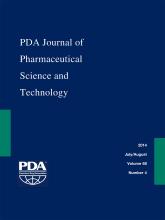Research ArticleTechnology/Application
Human Factors Studies for Injectable Combination Products: From Planning to Reporting
John K. Towns
PDA Journal of Pharmaceutical Science and Technology July 2014, 68 (4) 347-361; DOI: https://doi.org/10.5731/pdajpst.2014.00983
John K. Towns
Eli Lilly and Company, Lilly Corporate Center, Indianapolis, IN 47906

References
- 1.↵
FDA. Design Control Guidance for Medical Device Manufacturers, March 11, 1997.
- 2.↵
- Weinger M. B.,
- Wiklund M. E.,
- Gardner-Bonneau D. J.
- 3.↵
ISO/IEC 62366:2007, Medical devices—Application of usability engineering to medical devices. Geneva, International Electrotechnical Commission.
- 4.↵
AAMI/ANSI HE75:2009, Human Factors Engineering—Design of Medical Devices.
- 5.↵
AAMI/ANSI/ISO 14971:2012, Medical Devices—Application of risk management to medical devices. International Organization for Standardization: Geneva, Switzerland.
- 6.↵
ISO/IEC 60601-1-8:2006, Medical electrical equipment—Part 1-8: General requirements for basic safety and essential performance—Collateral Standard: General requirements, tests and guidance for alarm systems in medical electrical equipment and medical electrical systems. International Electrotechnical Commission: Geneva, Switzerland.
- 7.↵
AAMI/ANSI HE74:2001/(R)2009, Human Factors Design Process for Medical Devices.
- 8.
FDA Guidance for Industry and FDA Premarket and Design Control Reviewers Medical Device Use-Safety: Incorporating Human Factors Engineering into Risk Management. July 2000.
- 9.↵
FDA Draft Guidance for Industry and FDA Staff, Applying Human Factors and Usability Engineering to Optimize Medical Device Design. June 2011.
- 10.
FDA Draft Guidance for Industry and FDA Staff: Design Considerations for Devices Intended for Home Use. December 2012.
- 11.
FDA Draft Guidance for Industry: Safety Considerations for Product Design to Minimize Medication Errors. December 2012.
- 12.
FDA Draft Guidance for Industry and FDA Staff: Submissions for Post-approval Modifications to a Combination Product Approved Under a BLA, NDA, or PMA. January 2013.
- 13.↵
FDA Draft Guidance for Industry: Safety Considerations for Container Labels and Carton Labeling Design To Minimize Medication Errors. April 2013.
- 14.
FDA Draft Guidance for Industry and FDA Staff: Glass Syringes for Delivering Drug and Biological Products: Technical Information To Supplement International Organization for Standardization (ISO) Standard 11040-4. April 2013.
- 15.↵
FDA Draft Guidance for Industry, Rheumatoid Arthritis: Developing Drug Products for Treatment. May 2013.
- 16.
FDA Guidance for Industry and FDA Staff: Technical Considerations for Pen, Jet, and Related Injectors Intended for Use with Drugs and Biological Products. June 2013.
- 17.↵
- 18.↵
Master Files: Introduction to Master Files for Devices (MAFs), FDA CDRH Website, www.fda.gov/MedicalDevices/DeviceRegulationsandGuidance.
- 19.↵
FDA Guidance on Medical Device Patient Labeling; Final Guidance for Industry and FDA Reviewers. April 2001.
- 20.↵
Wyeth vs Levine, 555 U.S. 555, Supreme Court of United States, Decision: March 4, 2009.
- 21.↵
FDA Guidance. Deciding When to Submit a 510(k) for a Change to an Existing Device, January 4, 1997.
In This Issue
PDA Journal of Pharmaceutical Science and Technology
Vol. 68, Issue 4
July/August 2014
Human Factors Studies for Injectable Combination Products: From Planning to Reporting
John K. Towns
PDA Journal of Pharmaceutical Science and Technology Jul 2014, 68 (4) 347-361; DOI: 10.5731/pdajpst.2014.00983
Jump to section
- Article
- Abstract
- Introduction
- Renewed Emphasis on HF
- Scope of HF
- Risk Evaluation and Mitigation
- Formative Evaluations and Summative Validation HF Testing
- Training Decay
- Submitting HF Protocols
- End User Groups
- Usability Testing and Clinical Experience
- Submission of HF in Marketing Application
- Promotional Claims
- Post-Approval Changes
- Conclusions
- Conflict of Interest Declaration
- Acknowledgements
- References
- Figures & Data
- References
- Info & Metrics
Related Articles
- No related articles found.





